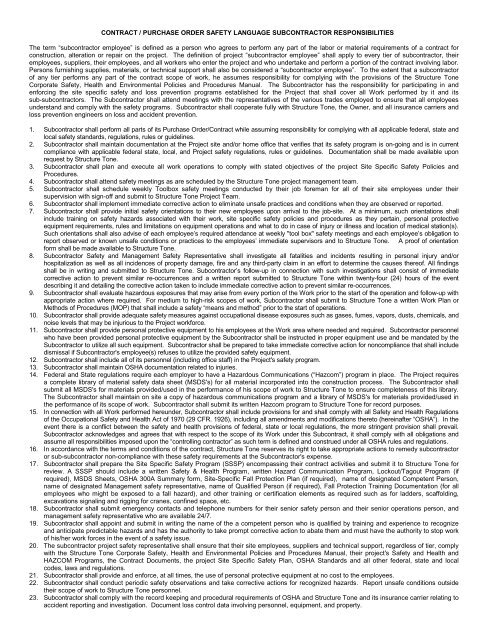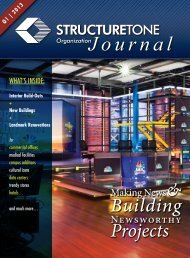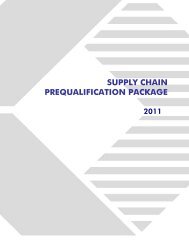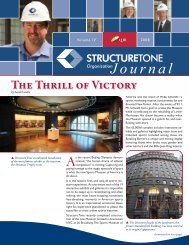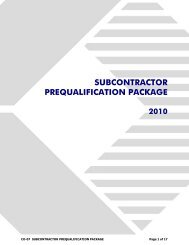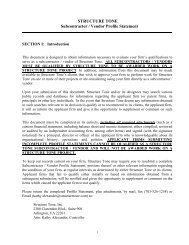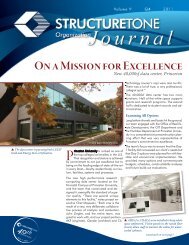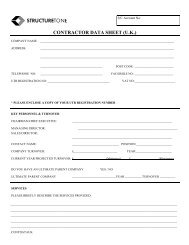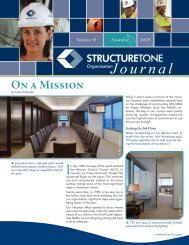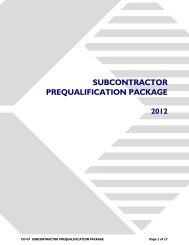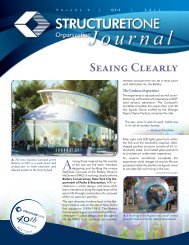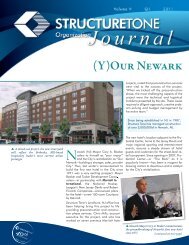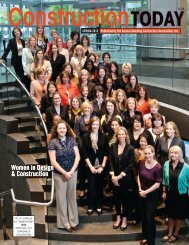contract / purchase order safety language - Structure Tone Inc.
contract / purchase order safety language - Structure Tone Inc.
contract / purchase order safety language - Structure Tone Inc.
Create successful ePaper yourself
Turn your PDF publications into a flip-book with our unique Google optimized e-Paper software.
CONTRACT / PURCHASE ORDER SAFETY LANGUAGE SUBCONTRACTOR RESPONSIBILITIES<br />
The term “sub<strong>contract</strong>or employee” is defined as a person who agrees to perform any part of the labor or material requirements of a <strong>contract</strong> for<br />
construction, alteration or repair on the project. The definition of project “sub<strong>contract</strong>or employee” shall apply to every tier of sub<strong>contract</strong>or, their<br />
employees, suppliers, their employees, and all workers who enter the project and who undertake and perform a portion of the <strong>contract</strong> involving labor.<br />
Persons furnishing supplies, materials, or technical support shall also be considered a “sub<strong>contract</strong>or employee”. To the extent that a sub<strong>contract</strong>or<br />
of any tier performs any part of the <strong>contract</strong> scope of work, he assumes responsibility for complying with the provisions of the <strong>Structure</strong> <strong>Tone</strong><br />
Corporate Safety, Health and Environmental Policies and Procedures Manual. The Sub<strong>contract</strong>or has the responsibility for participating in and<br />
enforcing the site specific <strong>safety</strong> and loss prevention programs established for the Project that shall cover all Work performed by it and its<br />
sub-sub<strong>contract</strong>ors. The Sub<strong>contract</strong>or shall attend meetings with the representatives of the various trades employed to ensure that all employees<br />
understand and comply with the <strong>safety</strong> programs. Sub<strong>contract</strong>or shall cooperate fully with <strong>Structure</strong> <strong>Tone</strong>, the Owner, and all insurance carriers and<br />
loss prevention engineers on loss and accident prevention.<br />
1. Sub<strong>contract</strong>or shall perform all parts of its Purchase Order/Contract while assuming responsibility for complying with all applicable federal, state and<br />
local <strong>safety</strong> standards, regulations, rules or guidelines.<br />
2. Sub<strong>contract</strong>or shall maintain documentation at the Project site and/or home office that verifies that its <strong>safety</strong> program is on-going and is in current<br />
compliance with applicable federal state, local, and Project <strong>safety</strong> regulations, rules or guidelines. Documentation shall be made available upon<br />
request by <strong>Structure</strong> <strong>Tone</strong>.<br />
3. Sub<strong>contract</strong>or shall plan and execute all work operations to comply with stated objectives of the project Site Specific Safety Policies and<br />
Procedures.<br />
4. Sub<strong>contract</strong>or shall attend <strong>safety</strong> meetings as are scheduled by the <strong>Structure</strong> <strong>Tone</strong> project management team.<br />
5. Sub<strong>contract</strong>or shall schedule weekly Toolbox <strong>safety</strong> meetings conducted by their job foreman for all of their site employees under their<br />
supervision with sign-off and submit to <strong>Structure</strong> <strong>Tone</strong> Project Team.<br />
6. Sub<strong>contract</strong>or shall implement immediate corrective action to eliminate unsafe practices and conditions when they are observed or reported.<br />
7. Sub<strong>contract</strong>or shall provide initial <strong>safety</strong> orientations to their new employees upon arrival to the job-site. At a minimum, such orientations shall<br />
include training on <strong>safety</strong> hazards associated with their work, site specific <strong>safety</strong> policies and procedures as they pertain, personal protective<br />
equipment requirements, rules and limitations on equipment operations and what to do in case of injury or illness and location of medical station(s).<br />
Such orientations shall also advise of each employee’s required attendance at weekly "tool box" <strong>safety</strong> meetings and each employee’s obligation to<br />
report observed or known unsafe conditions or practices to the employees’ immediate supervisors and to <strong>Structure</strong> <strong>Tone</strong>. A proof of orientation<br />
form shall be made available to <strong>Structure</strong> <strong>Tone</strong>.<br />
8. Sub<strong>contract</strong>or Safety and Management Safety Representative shall investigate all fatalities and incidents resulting in personal injury and/or<br />
hospitalization as well as all incidences of property damage, fire and any third-party claim in an effort to determine the causes thereof. All findings<br />
shall be in writing and submitted to <strong>Structure</strong> <strong>Tone</strong>. Sub<strong>contract</strong>or’s follow-up in connection with such investigations shall consist of immediate<br />
corrective action to prevent similar re-occurrences and a written report submitted to <strong>Structure</strong> <strong>Tone</strong> within twenty-four (24) hours of the event<br />
describing it and detailing the corrective action taken to include immediate corrective action to prevent similar re-occurrences.<br />
9. Sub<strong>contract</strong>or shall evaluate hazardous exposures that may arise from every portion of the Work prior to the start of the operation and follow-up with<br />
appropriate action where required. For medium to high-risk scopes of work, Sub<strong>contract</strong>or shall submit to <strong>Structure</strong> <strong>Tone</strong> a written Work Plan or<br />
Methods of Procedures (MOP) that shall include a <strong>safety</strong> “means and method” prior to the start of operations.<br />
10. Sub<strong>contract</strong>or shall provide adequate <strong>safety</strong> measures against occupational disease exposures such as gases, fumes, vapors, dusts, chemicals, and<br />
noise levels that may be injurious to the Project workforce.<br />
11. Sub<strong>contract</strong>or shall provide personal protective equipment to his employees at the Work area where needed and required. Sub<strong>contract</strong>or personnel<br />
who have been provided personal protective equipment by the Sub<strong>contract</strong>or shall be instructed in proper equipment use and be mandated by the<br />
Sub<strong>contract</strong>or to utilize all such equipment. Sub<strong>contract</strong>or shall be prepared to take immediate corrective action for noncompliance that shall include<br />
dismissal if Sub<strong>contract</strong>or's employee(s) refuses to utilize the provided <strong>safety</strong> equipment.<br />
12. Sub<strong>contract</strong>or shall include all of its personnel (including office staff) in the Project's <strong>safety</strong> program.<br />
13. Sub<strong>contract</strong>or shall maintain OSHA documentation related to injuries.<br />
14. Federal and State regulations require each employer to have a Hazardous Communications (“Hazcom”) program in place. The Project requires<br />
a complete library of material <strong>safety</strong> data sheet (MSDS's) for all material incorporated into the construction process. The Sub<strong>contract</strong>or shall<br />
submit all MSDS's for materials provided/used in the performance of his scope of work to <strong>Structure</strong> <strong>Tone</strong> to ensure completeness of this library.<br />
The Sub<strong>contract</strong>or shall maintain on site a copy of hazardous communications program and a library of MSDS's for materials provided/used in<br />
the performance of its scope of work. Sub<strong>contract</strong>or shall submit its written Hazcom program to <strong>Structure</strong> <strong>Tone</strong> for record purposes.<br />
15. In connection with all Work performed hereunder, Sub<strong>contract</strong>or shall include provisions for and shall comply with all Safety and Health Regulations<br />
of the Occupational Safety and Health Act of 1970 (29 CFR. 1926), including all amendments and modifications thereto (hereinafter “OSHA”). In the<br />
event there is a conflict between the <strong>safety</strong> and health provisions of federal, state or local regulations, the more stringent provision shall prevail.<br />
Sub<strong>contract</strong>or acknowledges and agrees that with respect to the scope of its Work under this Sub<strong>contract</strong>, it shall comply with all obligations and<br />
assume all responsibilities imposed upon the “controlling <strong>contract</strong>or” as such term is defined and construed under all OSHA rules and regulations.<br />
16. In accordance with the terms and conditions of the <strong>contract</strong>, <strong>Structure</strong> <strong>Tone</strong> reserves its right to take appropriate actions to remedy sub<strong>contract</strong>or<br />
or sub-sub<strong>contract</strong>or non-compliance with these <strong>safety</strong> requirements at the Sub<strong>contract</strong>or's expense.<br />
17. Sub<strong>contract</strong>or shall prepare the Site Specific Safety Program (SSSP) encompassing their <strong>contract</strong> activities and submit it to <strong>Structure</strong> <strong>Tone</strong> for<br />
review. A SSSP should include a written Safety & Health Program, written Hazard Communication Program, Lockout/Tagout Program (if<br />
required), MSDS Sheets, OSHA 300A Summary form, Site-Specific Fall Protection Plan (if required), name of designated Competent Person,<br />
name of designated Management <strong>safety</strong> representative, name of Qualified Person (if required), Fall Protection Training Documentation (for all<br />
employees who might be exposed to a fall hazard), and other training or certification elements as required such as for ladders, scaffolding,<br />
excavations signaling and rigging for cranes, confined space, etc.<br />
18. Sub<strong>contract</strong>or shall submit emergency contacts and telephone numbers for their senior <strong>safety</strong> person and their senior operations person, and<br />
management <strong>safety</strong> representative who are available 24/7.<br />
19. Sub<strong>contract</strong>or shall appoint and submit in writing the name of the a competent person who is qualified by training and experience to recognize<br />
and anticipate predictable hazards and has the authority to take prompt corrective action to abate them and must have the authority to stop work<br />
of his/her work forces in the event of a <strong>safety</strong> issue.<br />
20. The sub<strong>contract</strong>or project <strong>safety</strong> representative shall ensure that their site employees, suppliers and technical support, regardless of tier, comply<br />
with the <strong>Structure</strong> <strong>Tone</strong> Corporate Safety, Health and Environmental Policies and Procedures Manual, their project's Safety and Health and<br />
HAZCOM Programs, the Contract Documents, the project Site Specific Safety Plan, OSHA Standards and all other federal, state and local<br />
codes, laws and regulations.<br />
21. Sub<strong>contract</strong>or shall provide and enforce, at all times, the use of personal protective equipment at no cost to the employees.<br />
22. Sub<strong>contract</strong>or shall conduct periodic <strong>safety</strong> observations and take corrective actions for recognized hazards. Report unsafe conditions outside<br />
their scope of work to <strong>Structure</strong> <strong>Tone</strong> personnel.<br />
23. Sub<strong>contract</strong>or shall comply with the record keeping and procedural requirements of OSHA and <strong>Structure</strong> <strong>Tone</strong> and its insurance carrier relating to<br />
accident reporting and investigation. Document loss control data involving personnel, equipment, and property.
24. Sub<strong>contract</strong>or shall report immediately any accident/incident involving employees and provide accident, insurance and hospital reports in a timely<br />
fashion per section 3 of the <strong>Structure</strong> <strong>Tone</strong> Safety Manual.<br />
25. Sub<strong>contract</strong>or shall provide for <strong>safety</strong> planning in the scheduling and coordination of the work.<br />
26. Sub<strong>contract</strong>or shall conduct periodic <strong>safety</strong> meetings with employees, foremen and sub<strong>contract</strong>ors, and direct sub<strong>contract</strong>ors to issue <strong>safety</strong><br />
instructions with work assignments including training to use the required tools, and to recognize hazards associated with the work environment.<br />
Provide <strong>safety</strong> training for all aspects of their job duties as required by OSHA (and re-training when necessary).<br />
27. Where a designated site <strong>safety</strong> manager is required by <strong>contract</strong> he/she shall meet the following criteria:<br />
a. Successfully completed an OSHA 30 hour construction <strong>safety</strong> course within the last five years.<br />
b. Be recognized by the Sub<strong>contract</strong>or as competent person in accordance with OSHA definitions.<br />
c. Have the ability to recognize hazards associated with the scope of work.<br />
28. If <strong>Structure</strong> <strong>Tone</strong> determines a Sub<strong>contract</strong>or’s work is considered a high hazard (crane lifts, unusual lifts, extensive scaffolding, demolition,<br />
excavation, fire or smoke generating activities, concrete formwork, pre-cast concrete, steel erection, shaft work, confined space, work at heights,<br />
work at depths, etc.) the sub<strong>contract</strong>or shall provide a written Job Hazard Analysis (JHA) and/or a written Method of Procedures (MOP). A joint<br />
meeting shall be held to determine the need for a full time dedicated <strong>safety</strong> manager and review/coordinate the plan with the Owner or other<br />
sub<strong>contract</strong>ors as required.<br />
29. NON COMPLIANCE:<br />
a. Sub<strong>contract</strong>or’s with a on-site <strong>safety</strong> work history which does not meet <strong>Structure</strong> <strong>Tone</strong>’s expectations shall be required to designate a full<br />
time, on-site, dedicated <strong>safety</strong> person meeting the requirements of 27 (a-c).<br />
b. For the purpose of this section, work history includes, but not limited to: on-site injury rates at or above the National Average for recordable<br />
or loss time injuries; issued <strong>safety</strong> violations, issued by <strong>Structure</strong> <strong>Tone</strong> or a regulatory authorities, compared to other <strong>Structure</strong> <strong>Tone</strong>’s<br />
jobsites of the same trade; and lack of <strong>safety</strong> participation for required meetings and documentations and continued non-compliance.<br />
c. The Foreman shall be required to prepare and submit a daily JHA covering that day’s work and working conditions.<br />
d. Final determination of <strong>safety</strong> work history expectations shall be the discretion of the <strong>Structure</strong> <strong>Tone</strong> Safety Director.<br />
30. <strong>Structure</strong> <strong>Tone</strong>, in attempt to be a leader in <strong>safety</strong>, shall strive to require all sub<strong>contract</strong>or foremen and/or competent persons to be OSHA 30<br />
Hour Trained.<br />
31. The project employees shall comply with all Federal and State Safety and Health Standards/Laws and all site employees are charged with<br />
obeying the law. The standards and laws contained in Federal and State mandates are available for review at the <strong>Structure</strong> <strong>Tone</strong> job site field<br />
office. Rules cannot be written to cover every possible situation that may arise at the job site. Therefore, certain responsibilities rest upon the<br />
site employee, namely the protection of themselves and protection of fellow workers.<br />
32. The following rules are important to the <strong>safety</strong> of all personnel on the project and are to be enforced by sub<strong>contract</strong>or management:<br />
a. Possession of or working under the influence of alcohol or drugs is prohibited and subject to immediate dismissal.<br />
b. Temporary power for all power tools and cord sets shall be protected by an operable Ground Fault Circuit Interrupter (GFCI) plugged in at<br />
the power source or a GFCI circuit breaker. If no GFCI outlets are available, the sub<strong>contract</strong>or shall provide a GFCI “pigtail”. Above 110 V,<br />
any cord and plug set shall be protected via GFCI or Assured Equipment Grounding Conductor Program (AEGCP).<br />
c. All electrical power sources, tools, and extension cords shall be grounded or double insulated.<br />
d. Hazard Communication and Lockout/Tagout Programs shall be observed.<br />
e. Employees are to be alert at all times and report all unsafe conditions or acts, along with all accidents, to <strong>Structure</strong> <strong>Tone</strong> immediately.<br />
f. Appropriate work attire shall be worn at all times.<br />
g. Use of personal protective equipment supplied by the employer must be worn.<br />
h. Hard hats and Safety glasses must be worn as required by task and/or hazard.<br />
i. Gloves must be worn as required by task such as when handling objects or substances that could cut, tear, burn or injure hands.<br />
j. Traffic/Safety vests must be worn as required by task.<br />
k. "Horseplay" and other inappropriate behaviors are prohibited.<br />
l. Maintaining good housekeeping is mandatory at all times.<br />
m. Fire protection equipment is not to be tampered with or removed from its assigned location.<br />
n. There is no substitution for the exercise of good professional judgment.<br />
o. Site employees are to inspect all hand tools and extension cords they will be using. Those tools and extension cords that are found to be<br />
defective are to be taken out of service immediately. Other equipment, such as scaffolding and ladders shall be inspected for any defects<br />
by the sub<strong>contract</strong>or’s competent person prior to use. If equipment is found to be defective or unserviceable, it is to be immediately brought<br />
to the attention of the supervisor and removed from service.<br />
p. Only authorized and properly instructed/trained site employees shall operate machinery, equipment, vehicles, tools and especially powderactuated<br />
tools.<br />
q. Vehicles are to be operated and driven in a safe manner at all times and by no one other than the assigned operator.<br />
r. Firearms are prohibited on a project. Anyone found with such shall be immediately terminated and the authorities shall be notified.<br />
s. Fighting on the job is cause for the immediate termination of all participants.<br />
t. Proper lifting techniques are to be utilized. Workers are not to lift or push heavy objects. Get help if necessary.<br />
u. Do not enter roped off/barricaded areas unless authorized to do so.<br />
v. Approved respirators shall be used when conditions warrant and procedures in the Respiratory Protection Program strictly followed.<br />
w. Modification or alteration of any piece of personal protective equipment is strictly prohibited. Defective or damaged personal protective<br />
equipment shall be returned for replacement or repair.<br />
x. "No Smoking" rules shall be obeyed. Smoking is prohibited throughout the job site.<br />
y. The use of gasoline is prohibited for the cleaning of equipment and tools or for starting fires. Gasoline engines shall be shut off and allowed<br />
to cool before refueling.<br />
z. The use of plastic gas cans for storing combustible/flammable liquids on the site is prohibited. Use only approved metal containers.<br />
aa. Tampering with fire fighting or life <strong>safety</strong> equipment is prohibited and grounds for termination.<br />
bb. When working with mobile cranes or tower cranes effective signaling must be used in <strong>order</strong> to achieve safe rigging practices. The <strong>Structure</strong><br />
<strong>Tone</strong> crane policy within the Safety Manual must be followed.<br />
cc. The use of portable FM/AM, IPod, MP3 radios or other devices which affect the ability to hear emergency instructions and warnings on the<br />
site is prohibited at all times.<br />
dd. No site employees shall be exposed to a fall hazard greater than six (6') feet above a lower level. When an employee observes a fall<br />
hazard, they shall notify their supervisor of the hazard. The responsible Sub<strong>contract</strong>or shall immediately correct the hazard. 100%<br />
continuous fall protection, for fall hazards greater than six (6’) feet, shall be implemented.<br />
ee. The Sub<strong>contract</strong>or is responsible to obtain and faithfully execute and comply with the most current version of the <strong>Structure</strong> <strong>Tone</strong> Corporate<br />
Safety, Health and Environmental Policies and Procedures Manual available at www.structuretone.com which is hereby incorporated by<br />
reference and made a part hereof as if fully set forth in length.


